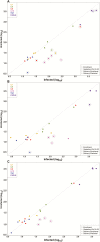Systemic Inflammatory Response to Malaria During Pregnancy Is Associated With Pregnancy Loss and Preterm Delivery
- PMID: 29020221
- PMCID: PMC5850414
- DOI: 10.1093/cid/cix623
Systemic Inflammatory Response to Malaria During Pregnancy Is Associated With Pregnancy Loss and Preterm Delivery
Abstract
Background: Pregnancy malaria (PM) is associated with a proinflammatory immune response characterized by increased levels of cytokines and chemokines such as tumor necrosis factor-α, interferon-γ, interleukin 10 (IL-10), and CXCL9. These changes are associated with poor outcomes including low birthweight delivery and maternal anemia. However, it is unknown if inflammatory pathways during malaria are related to pregnancy loss and preterm delivery (PTD).
Methods: Cytokine and chemokine levels were measured in maternal peripheral blood at enrollment, gestational week 30-32, and delivery, and in placental blood, of 638 women during a longitudinal cohort study in Ouelessebougou, Mali. Plasmodium falciparum infection was assessed by blood smear microscopy at all visits.
Results: PM was associated with increased levels of cytokines and chemokines including IL-10 and CXCL9. In a competing risks model adjusted for known covariates, high CXCL9 levels measured in the peripheral blood during pregnancy were associated with increased risk of pregnancy loss and PTD. At delivery, high IL-10 levels in maternal blood were associated with an increase in pregnancy loss, and increased IL-1β levels in placental blood were associated with pregnancy loss and PTD.
Conclusions: PM is associated with increased proinflammatory cytokine and chemokine levels in placental and maternal peripheral blood. Systemic inflammatory responses to malaria during pregnancy predict increased risk of pregnancy loss and PTD.
Clinical trials registration: NCT01168271.
Keywords: CXCL9; placental malaria; pregnancy loss; preterm delivery.
Published by Oxford University Press for the Infectious Diseases Society of America 2017. This work is written by (a) US Government employee(s) and is in the public domain in the US.
Figures

References
-
- McGregor IA. Epidemiology, malaria and pregnancy. Am J Trop Med Hyg 1984; 33:517–25. - PubMed
-
- Desai M, ter Kuile FO, Nosten F et al. . Epidemiology and burden of malaria in pregnancy. Lancet Infect Dis 2007; 7:93–104. - PubMed
-
- van Geertruyden JP, Thomas F, Erhart A, D’Alessandro U. The contribution of malaria in pregnancy to perinatal mortality. Am J Trop Med Hyg 2004; 71:35–40. - PubMed
MeSH terms
Substances
Associated data
LinkOut - more resources
Full Text Sources
Other Literature Sources
Medical
Research Materials

